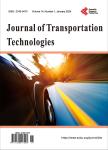Characterizing Peak-Time Traffic Jam Incidents in Kampala Using Exploratory Data Analysis
Characterizing Peak-Time Traffic Jam Incidents in Kampala Using Exploratory Data Analysis作者机构:Department of Computer Science and Information Technology Islamic University in Uganda Kampala Uganda Department of Information and Communication Technology Equator University of Science and Technology Masaka Uganda
出 版 物:《Journal of Transportation Technologies》 (交通科技期刊(英文))
年 卷 期:2023年第13卷第1期
页 面:61-86页
学科分类:0809[工学-电子科学与技术(可授工学、理学学位)] 08[工学]
主 题:Motorist Behavior Traffic Jam Traffic Congestion Urban Road-Networks Motorized Transport Traffic Clusters
摘 要:Traffic congestion is associated with increased environmental pollutions, as well as reduced socio-economic productivity due to significant delays in travel times. The consequences are worse in least developed countries where motorized road transport networks are often inefficiently managed in addition to being largely underdeveloped. Recent research on traffic congestion has mostly focused on infrastructural aspects of road networks, with little or no emphasis at all on motorists’ on-the-road behavior (MB). The current study thus aimed to bridge this knowledge gap by characterizing traffic jam incidents (TJI) observed over a period of 80 days in Uganda’s Capital City, Kampala. MB as well as road network infrastructural factors such as road blockage (RB), were captured for each of the observed TJI. A total of 483 peak-time TJI were recorded, and exploratory data analysis (EDA) subsequently performed on the TJI dataset. EDA involved Hierarchical clustering analysis (HCA) and K-means clustering of the TJI dataset, as well as a detailed descriptive statistical analysis of both the entire dataset and the emerging TJI clusters. A highlight finding of this study is that 48.2% of the observed TJIs were as a result of on-the-road motorist behavior. Furthermore, the intervention of traffic police officers in a bid to regulate traffic flow was equally responsible for 25.9% of the TJIs observed in this study. Overall, these results indicate that whereas road infrastructural improvement is warranted in order to improve traffic flow, introducing interventions to address inappropriate on-the-road motorists’ behavior could alone improve traffic flow in Kampala, by over 48%. Additionally, in-order to effectively regulate traffic flow in Kampala and other least developed cities with similar traffic congestion management practices, motorists’ on-the-road behavior ought to be factored into any data-driven mechanisms deployed to regulate traffic flow and thus potentially significantly



